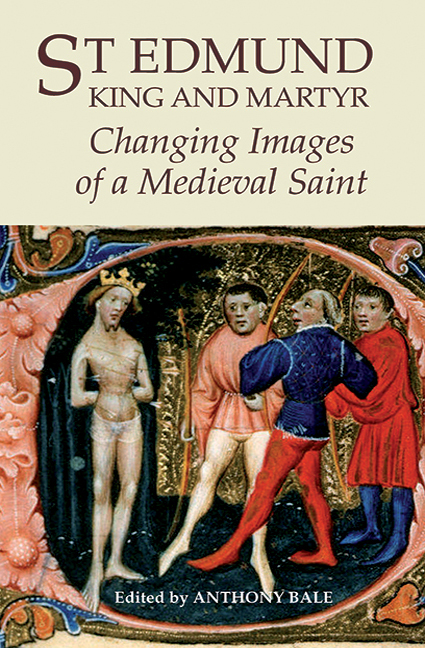Book contents
- Frontmatter
- Contents
- Preface
- List of Contributors
- List of Abbreviations
- Introduction: St Edmund's Medieval Lives
- 1 King, Martyr and Virgin: Imitatio Christi in Ælfric's Life of St Edmund
- 2 Chronology, Genealogy and Conversion: The Afterlife of St Edmund in the North
- 3 Geoffrey of Wells’ Liber de infantia sancti Edmundi and the ‘Anarchy’ of King Stephen's Reign
- 4 Music and Identity in Medieval Bury St Edmunds
- 5 Medieval images of St Edmund in Norfolk Churches
- 6 John Lydgate's Lives of Ss Edmund and Fremund: Politics, Hagiography and Literature
- 7 St Edmund in Fifteenth-Century London: The Lydgatian Miracles of St Edmund
- 8 The Later Lives of St Edmund: John Lydgate to John Stow
- Select Bibliography
- Index
- Miscellaneous Endmatter
7 - St Edmund in Fifteenth-Century London: The Lydgatian Miracles of St Edmund
Published online by Cambridge University Press: 11 May 2017
- Frontmatter
- Contents
- Preface
- List of Contributors
- List of Abbreviations
- Introduction: St Edmund's Medieval Lives
- 1 King, Martyr and Virgin: Imitatio Christi in Ælfric's Life of St Edmund
- 2 Chronology, Genealogy and Conversion: The Afterlife of St Edmund in the North
- 3 Geoffrey of Wells’ Liber de infantia sancti Edmundi and the ‘Anarchy’ of King Stephen's Reign
- 4 Music and Identity in Medieval Bury St Edmunds
- 5 Medieval images of St Edmund in Norfolk Churches
- 6 John Lydgate's Lives of Ss Edmund and Fremund: Politics, Hagiography and Literature
- 7 St Edmund in Fifteenth-Century London: The Lydgatian Miracles of St Edmund
- 8 The Later Lives of St Edmund: John Lydgate to John Stow
- Select Bibliography
- Index
- Miscellaneous Endmatter
Summary
as the essays in this volume show, a saint's cult is fed by and feeds into a wide range of cultural artefacts: not just ‘official’ religious media, but also texts and images, musical and dramatic productions, which depend on exchange between clerical and secular arenas, between priestly and demotic interests. This essay considers a relatively minor element in the later medieval cult of St Edmund: a miracle text, the Lydgatian Miracles of St Edmund, written in the mid-fifteenth century, almost certainly under the auspices of the Abbey at Bury St Edmunds.
I am concerned in this essay with identifying, describing and analysing the text's ‘environment’. This term is used advisedly, to connote something different from the text's ‘occasion’ (that is, the persons, institutions or events for whom or for which the text was written) or its general context (the background conditions against which the text can be seen to exist). In seeking a textual environment I hope to be able to account for the variety of factors – some contextual, some authorial, some occasional, some pertaining to audience and patronage – that made the cult of St Edmund attractive and resonant to audiences in fifteenth-century Suffolk and London. While one can establish a credible and precise occasion for at least part of the poem (described further below), the Miracles of St Edmund cannot be accounted for by patronage alone but must be seen within and against the specific dynamics of literary and devotional fashions of the 1440s, as well as a politics of hagiography concerning the reshaping of the cult of St Edmund.
The Miracles comprise fifty-eight eight-line stanzas, of three similar but separate miracle narratives, hereafter called miracles A, B and C. Miracle A (lines 1–152) is set at London, 20 November 1441 (the Feast of St Edmund). Miracle B (lines 393–465) is set at Bury St Edmunds, 28 April 1444 (the Eve of the Translation of St Edmund). Miracle C (lines 393–465) is also set at Bury, and takes place on 8 July 1444. Each miracle describes an injured child, saved or revived by the invocation of St Edmund.
- Type
- Chapter
- Information
- St Edmund, King and MartyrChanging Images of a Medieval Saint, pp. 145 - 162Publisher: Boydell & BrewerPrint publication year: 2009

